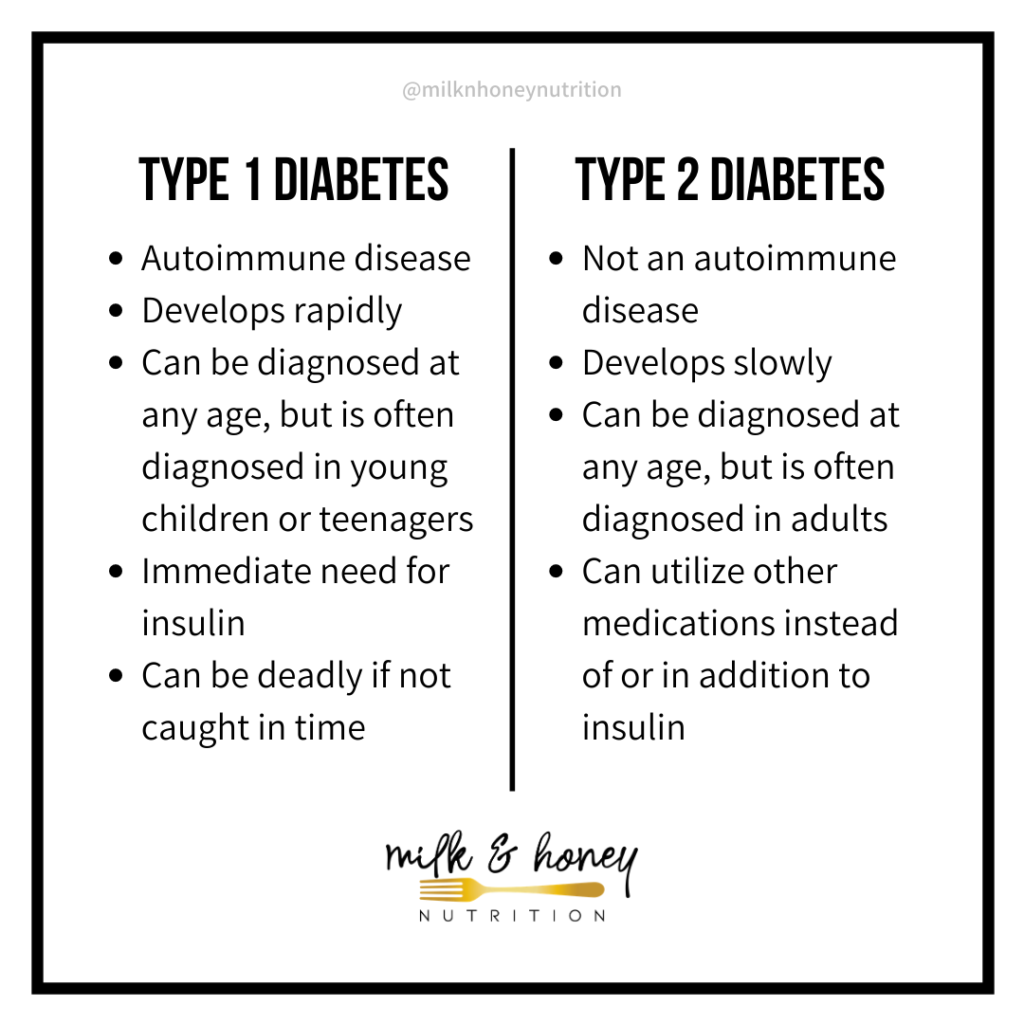
The most frequently asked question about diabetes is often what’s the difference between type 1 vs type 2 diabetes?
Anyone with type 1 or type 2 diabetes will tell you that while there are some similarities, there are a lot of differences between type 1 and type 2 diabetes. So, let’s compare the diagnosis, treatment, and common symptoms of type 1 vs type 2 diabetes.
What’s the difference between type 1 and type 2 diabetes?
Diabetes mellitus is a disease that prevents the body from properly absorbing the carbohydrate you eat, either because the pancreas does to not make insulin, or the insulin the pancreas makes is not effective.
When the pancreas does not make enough insulin, this is called type 1 diabetes. When the insulin the pancreas makes is not as effective as it should be, this is called type 2 diabetes. Both types of diabetes result in elevated levels of glucose in the blood stream.
Let’s look at type 1 vs type 2 diabetes in some key areas.
- Type 1 diabetes is an autoimmune disease. Type 2 is not.
- Type 1 diabetes develops rapidly over a matter of weeks. Type 2 diabetes develops slowly over years.
- Type 1 diabetes can be diagnosed at any age but is often diagnosed in children or teenagers. Type 2 can also be diagnosed at any age but is usually diagnosed in adults.
- Type 1 diabetes requires insulin treatment immediately. Type 2 diabetes, if caught early enough, can be managed without medication or with oral medications and does not require insulin immediately.
- Type 1 diabetes can be deadly if not caught in time. Many people can live with type 2 diabetes for years and not even know they have the disease.
The image below summarizes the primary differences of type 1 vs type 2 diabetes.

Interesting fact: there are also many other types of diabetes people can be diagnosed with in addition to type 1 and type 2 diabetes.
Which is worse type 1 or type 2 diabetes?
It’s important to remember that when we compare type 1 vs type 2 diabetes, we are really looking at two different diseases. Neither is worse or better than the other. They have different causes, symptoms, and treatments, but can ultimately have the same end result on the body.
Who is most at risk for type 1 diabetes?
There are not many known risk factors for type 1 diabetes except for family history. You are at a much greater risk of developing type 1 diabetes if a parent or sibling has the disease. Because of this, we know that type 1 diabetes has some genetic component.
In the United States, people who are white are more likely to develop type 1 diabetes than African Americans or Hispanic Americans.
Who is most at risk for type 2 diabetes?
Well known risk factors for developing pre-diabetes or type 2 diabetes include:
- Having pre-diabetes
- >45 years old
- Family history of type 2 diabetes
- Not physically active regularly
- Previous gestational diabetes diagnosis
- Being African American, Hispanic/Latino American, American Indian, or Alaska Native (Type 2 diabetes incidence rates are dis-proportionately high in these populations compared to other races. Vast racial disparities and inequities exist in our current healthcare system that both directly and indirectly cause these higher diabetes rates. It’s extremely important that we understand we cannot reduce the burden of diabetes without acknowledging these inequalities.)

Type 1 vs Type 2 diabetes symptoms
When looking at the symptoms of type 1 vs type 2 diabetes, you may not notice a whole lot of differences. The symptoms are quite similar but will develop over a different timeline. Type 1 develops quite rapidly over a matter of weeks or a couple months and type 2 can develop over many years.
Common symptoms of diabetes include unexplained:
- Excessive thirst
- Excessive hunger
- Frequent urination
- Weight loss
- Weight gain
- Tiredness and fatigue
- Muscle loss
How can you tell if you have type 2 diabetes?
Many people may actually have type 2 diabetes and not even know it. The only way to truly know if you have diabetes or not is through a blood test and going to see your doctor. This is why going to your yearly check up with your doctor is so important!
Does type 1 diabetes affect sleep?
Fluctuating blood sugar levels can greatly impact the quality of the sleep you get each night. Because of this, someone with undiagnosed type 2 diabetes or poorly managed type 1 diabetes may experience poor sleep or restless sleep.

How to diagnose type 1 diabetes vs type 2 diabetes
Type 1 vs type 2 diabetes diagnosis are slightly different. Both types of diabetes are diagnosed with a HgbA1c (hemoglobin A1c) level of 6.5% or higher on two subsequent tests.
In addition to the HgbA1c, a doctor will also test for the presence of autoantibodies to diagnose type 1 diabetes.
Which type of diabetes are you born with?
While you are not born with diabetes, you can be born with a genetic predisposition to both type 1 and/or type 2 diabetes.
How do you get type one diabetes?
As we discussed previously, the only known risk factor for type 1 diabetes is family history. We still, even in 2021, don’t know exactly what causes the body’s immune system to attack the pancreas and develop type 1 diabetes.
Does eating a lot of sugar cause diabetes?
No! There are so many different factors that can play into a diabetes diagnosis. The notion that eating too much sugar causes diabetes could not be further from the truth. Even when looking at type 1 vs type 2 diabetes, eating too much sugar will not cause either type of diabetes.

Type 1 vs type 2 diabetes treatment
Type 1 diabetes is treated with insulin and blood sugar self monitoring. Insulin can be administered either via a syringe, pen, or insulin pump. Many people with type 1 may also wear a continuous glucose monitor as well.
Type 2 diabetes can be treated a number of different ways depending on what stage of the disease it is diagnosed at:
- Lifestyle modification
- Oral medication
- Insulin
Is type 1 diabetes curable?
There is no known cure for type 1 diabetes.
Can diabetes type 2 be cured?
While type 2 diabetes and pre-diabetes can go into remission, there is no true cure for type 2 diabetes.
Now, that you’ve got a good grasp on the differences between type 1 and type 2 diabetes, make sure to read more about other types of diabetes like LADA, MODY, and Type 3. And, regardless of which type of diabetes you or a loved one is managing, my cookbook The Easy Diabetes Cookbook is filled with easy and delicious recipes to help balance blood sugars!






